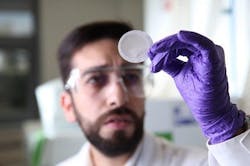LONDON, England – UK company G2O Water Technologies has signed an agreement with an unnamed consumer products company to test and evaluate its graphene-based water treatment filtration technology.
G2O’s technology works by creating low-cost printed graphenefilters or by applying a graphene coating to existing membranes used in water filtration processes.
This allows more water to pass through a membrane and is said to reduce the amount of energy needed to filter the water passing through the membrane by up to 50 percent.
The latest Innovate UK funding for G2O follows a previous £700,000 project grant awarded in 2015, which enabled the company to fund a two-year project with the Centre for Process Innovation (CPI), a UK-based technology innovation centre which is part of the High Value Manufacturing Catapult.
The project focused on transferring and scaling up the technology from laboratory to industry, ensuring the technology is usable with full quality control.
The technology has since been validated at CPI and the new grant will focus on transferring it to large-scale manufacturing.
That will include the use of industrial printing technology to manufacture membranes and validate their performance using prototypes and will involve collaboration with a number of UK partner organisations including speciality chemicals manufacturer, William Blythe and CPI.
Tim Harper, CEO and founder of G2O Water Technologies, said: “Many urban water supplies contain pollutants including pesticides, heavy metals and even plastic micro-fibres as identified in the recent report by Orb and the University of Minnesota School of Public Health. While this problem requires complex domestic water treatment systems, our technology makes obtaining clean water as simple as making a cup of filter coffee.”
###
Read more
Global ‘graphene rush’ continues as UK scientists stabilise membrane
Australian partnership hopes to disrupt filtration market with graphene-based tech
How will material developments (such as graphene) improve or change membrane desalination in the future?



